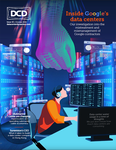The last two years have seen sweeping changes in day-to-day life for just about everyone across the globe, driven by the need for reduced contact and shifting requirements. The use of technology has rapidly expanded for remote working, learning, and entertainment, driving global demand for data and storage to record levels.
As we enter 2022, it appears that what began as emerging trends are here to stay, at least for a while. While we may not return to the exact same lockdown situations experienced around the world during 2020 that led to billions of people working from home, the current situation is that many companies have now adopted a hybrid model, with some staff working remotely and others in the office, relying on new applications in the cloud and on the desktop to maintain productivity and ensure teams can still work closely.
Trend 1: Rising infrastructure demand
You’re never far away from a news headline discussing the pros and cons of whether a hybrid approach to business is going to become the norm, even after the pandemic’s challenges have ended. Currently, outside of official government mandates to work from home, most companies are offering their staff the option to work outside the office for at least a few days of the working week.
One popular reason cited by those in favour of working from home is that the online and cloud tools millions of people have become accustomed to using regularly, such as Zoom, Skype and Microsoft Teams, have indeed worked extremely well and enabled productivity and collaboration to continue, even with staff working remotely.
Outside of work time, as people have generally been cautious about, or reduced social contact, they’ve turned to digital entertainment in record numbers, with video streaming and online gaming services growing immensely.
This demand has created enormous global growth in data consumption. data center and network capacity has to rise to meet this demand, creating pressure on providers of memory and storage technology to continue to innovate, with new, faster technology that offers increased throughput.
What began as short-term trends are likely to become permanent fixtures in 2022, with long-term changes to work and home life, so usage of digital entertainment and services will continue to grow.
Various sectors such as education and healthcare that quickly adopted new technology as a way to continue working during stay-at-home mandates have benefitted in many ways from greater adoption of digital technology. As an example, patients with mobility issues who may have found it difficult to attend in-person GP meetings can now expect better support for remote consultations. These sectors are likely to continue integrating digital systems in 2022.
Trend 2: Novel technologies
Changing trends in technology over the last two years aren’t only being driven by a need for reduced social contact. AI, machine learning, 5G and Edge, the proliferation of IoT devices, blockchain technology, augmented reality (AR) and virtual reality (VR) are all hot topics in the computing world and set for growth in 2022.
Since storage and memory plays a fundamental part of all digital systems, and are key to enabling these new technologies, so we can expect increased demand for on-device memory resources as well as data infrastructure to support them.
AI in particular creates a huge amount of data, so it’s natural to expect that as it slowly becomes closely integrated into our daily lives, in car technology for example, this will create an exponential rise in demand for storage capacity and performance.
Autonomous transport is set for further growth in 2022, spurring further demand for AI and creating more demand for on data and network infrastructure, as well as increasing use of IoT sensors.
The pressure on minimising physical contact and social distancing in stores could spur adoption of the use AR particularly in retail and travel, allowing greater remote interaction with products and creating new customer experiences. In 2022, expect to see more apps and online stores offering AR showcases of their products
Similarly in 2022 AR and VR technology can help product development teams accelerate the design process, and bring products to market more quickly.
Trend 3: Security
Cybersecurity is already one of the biggest issues any business faces, and the shift to hybrid working has created new problems for IT security departments to worry about. Outside of the protective umbrella of office networks, there’s a real risk of data breaches and devices have become more susceptible to malware attacks. This is against a background where ransomware is becoming a major threat that can entirely cripple a business.
To meet these challenges, zero trust authentication security models are growing in use, following recommendation from the UK’s NCSC. Quicker responses to zero-day attacks helps limit the fallout from security incidents, and solutions based on AI / machine learning could see increased deployment to enable tracing leaks faster.
VPN use will no doubt grow to support staff working from home, along with mandates on encrypted storage, particularly when hybrid work means critical data is constantly shifting between offices and external locations. Hardware-encrypted devices like USB are certain to remain best practice for endpoint cybersecurity, as the encryption process is kept separate from the rest of the machine.
Trend 4: Supply shortages
Limited supply of technology products over the last two years has been driven by rapidly increased demand, reduced production and disruption to supply chains, which was caused by a myriad of factors. Delays and reduced availability have slowed down rollouts of new technology as well as pushing up prices.
While much of the focus has been on processor shortages, the wider impact of a reduced supply of this key component has affected production of many kinds of products.
This trend will certainly continue in early 2022, and probably be felt for some time afterwards.
Trend 5: Skills shortages
For many the appeal of hybrid work is that it enables them to fit family responsibilities around work commitments without the pressure and lost hours of commuting, but also without sacrificing productivity, thanks to increased adoption of digital tools in the workplace and fast broadband connections that let people perform their role outside an office.
At the same time, although hiring enough skilled IT staff has always been an issue for businesses, it could become an even bigger problem in 2022 as companies find themselves dealing with a wider range of IT problems, particularly in security.
Since priorities of staff have changed, as they’ve become less satisfied with the status quo of corporate life, organizations may increasingly offer hybrid working as a carrot to attract people with the skills they need, allowing employees to work remotely wherever it’s possible.





